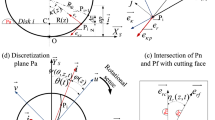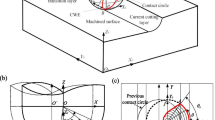Abstract
In high-speed ball end milling, cutting forces influence machinability, dimensional accuracy, tool deflection, tool failure, machine tool chatter and vibration, etc. Thus, an accurate prediction of cutting forces prior to actual machining is very much essential for a good insight into the process to produce good quality machined parts. In ball end milling, the cutting forces are proportional to the chip cross-sectional area and constant of proportionalities are referred as cutting force coefficients and they depend on many factors, like cutter geometry, cutting conditions, tool material and workpiece material properties. However, determining these specific cutting force coefficients in ball end milling process is not at all straightforward; rather it is fairly complex. Machining with higher cutting speed affects the chip formation mechanisms and finally causes a significant change in the cutting force coefficients. In the present study, the effect of rotational speeds has been investigated on the cutting force coefficients. A series of experiments have been performed at higher rotational speed. It has been found that the cutting force coefficients are influenced by rotational speed significantly. The results are also verified using experiments.












Similar content being viewed by others
Abbreviations
- a p :
-
Axial depth of cut (mm)
- a e :
-
Radial depth of cut(mm)
- f z :
-
Feed per tooth (mm/tooth)
- N :
-
Rotational speed (rpm)
- R :
-
Cutter radius (mm)
- R z :
-
Local radius of cutter (mm)
- R zi :
-
Local radius of ith cutting edge element on cutter (mm)
- R(δ i ):
-
Local radius of cutter considering local lag angle (mm)
- β :
-
Radial immersion angle (radian)
- κ :
-
Axial immersion angle (°)
- β ij :
-
Radial immersion angle of i th element of j th cutting edge (radian)
- δ i :
-
Local lag angle (°)
- δ i (z):
-
Local lag angle at axial position z (°)
- δo :
-
Maximum lag angle (°)
- θ :
-
Cutter rotation angle (radian)
- ϕ p :
-
Pitch angle (radian)
- ψ :
-
Helix angle (°)
- ψ i :
-
Local helix angle (°)
- \( \bar{F}_{x,y,z} \) :
-
Average force in x-, y- and z-directions (N)
References
FallboÈhmer P, RodrõÂguez CA, Èzel TO, Altan T (2000) High-speed machining of cast iron and alloy steels for die and mold manufacturing. J Mater Process Technol 98(1):104–115. doi:10.1016/S0924-0136(99),00311-8
Dawes RC, Aspinwall DK (1997) A review of ultrahigh speed milling of hardened steels. J Mater Process Technol 69(1–3):1–17. doi:10.1016/S0924-0136(96)00042-8
Dewes RC, Chua E, Ng KS, Newton PG, Aspinwall DK (1999) Temperature measurement when high speed machining hardened mould/die steel. J Mater Process Technol 92–93:293–301. doi:10.1016/S0924-0136(99)00116-8
McGee FJ (1979) High speed machining-study: methods for aluminium workpiece. Am Mach 121–126
Schulz H, Moriwaki T (1992) High-speed machining. Ann CIRP 41(2):637–643. doi:10.1016/S0007-8506(07)63250-8
Yang M, Park H (1991) The prediction of cutting force in ball-end milling. Int J Mach Tools Manuf 31(1):45–54. doi:10.1016/0890-6955(91)90050-D
Altintas Y, Spence A (1991) End milling force algorithms for CAD systems. Ann CIRP 40(1):31–34. doi:10.1016/S0007-8506(07)61927-1
Sadeghi MH, Haghighat H, Elbestawi MA (2003) A solid modeler based ball-end milling process simulation. Int J Adv Manuf Technol 22(11):775–785. doi:10.1007/s00170-002-1452-6
Wan M, Zhang WH, Qin GH, Tan G (2007) Efficient calibration of instantaneous cutting force coefficients and runout parameters for general end mills. Int J Mach Tools Manuf 47(11):1767–1776. doi:10.1016/j.ijmachtools.2006.06.012
Chiang ST, Tsai CM, Lee AC (1995) Analysis of cutting forces in ball-end milling. J Mater Process Technol 47:231–249. doi:10.1016/0924-0136(95)85001-5
Lee P, Altintas Y (1996) Predictions of ball-end milling forces from orthogonal cutting data. Int J Mach Tools Manuf 36(9):1059–1072. doi:10.1016/0890-6955(95)00081-X
Sun Y, Ren F, Guo D, Jia Z (2009) Estimation and experimental validation of cutting forces in ball-end milling of sculptured surfaces. Int J Mach Tools Manuf 49(15):1238–1244. doi:10.1016/j.ijmachtools.2009.07.015
Gao Ge WuB, Zhang D, Luo M (2013) Mechanistic identification of cutting force coefficients in bull nose milling process. Chin J Aeronaut 26(3):823–830. doi:10.1016/j.cja.2013.04.007
Wang M, Gao L, Zheng Y (2014) An examination of the fundamental mechanics of cutting force coefficients. Int J Mach Tools Manuf 78:1–7. doi:10.1016/j.ijmachtools.2013.10.008
Grossi N, Sallese L, Scippa A, Campatelli G (2015) Speed varying cutting force coefficient identification in milling. Precis Eng. doi:10.1016/j.precisioneng.2015.04.06
Ma J, Jia Z, Wang F, Ning F (2014) Spindle speed selection for high-speed milling of titanium alloy curved surface. Mater Manuf Process 29(3):364–369. doi:10.1080/10426914.2014.880458
Wojciechowski S, Twardowski TCP (2012) The analysis of specific cutting force coefficients including kinematic-geometric parameters after ball end milling of hardened steel. Proc CIRP 1:680–685. doi:10.1016/j.procir.2012.04.117
Altintas Y, Lee P (1998) Mechanics and dynamics of ball-end milling. ASME J Manuf Sci Eng 120(4):684–692. doi:10.1115/1.2830207
Altintas Y (2012) Manufacturing Automation-metal cutting mechanics and machine tool vibrations and CNC design, 2nd edn. Cambridge University Press, Cambridge
Gonzalo O, Beristain J, Jauregi H, Sanz C (2010) A method for the identification of the specific force coefficients for mechanistic milling simulation. Int J Mach Tools Manuf 50(9):765–774. doi:10.1016/j.ijmachtools.2010.05.009
Miyaguchi T, Masuda M, Takeoka E, Iwabe H (2001) Effect of tool stiffness upon tool wear in high spindle speed milling using small ball end mill. Precis Eng 25(2):145–154. doi:10.1016/S0141-6359(01)00067-8
Campatelli G, Scippa A (2012) Prediction of milling cutting force coefficients of Aluminum 6082-T4. Proc CIRP 1:563–568. doi:10.1016/j.procir.2012.04.100
Acknowledgements
The experimental work was carried out using Vertical Milling Center in Manufacturing Technology Laboratory, CSIR-CMERI, Durgapur, India. The authors acknowledge the support extended by Mr. S. Y. Pujar for his assistance in conducting experiments.
Author information
Authors and Affiliations
Corresponding author
Additional information
Technical Editor: Márcio Bacci da Silva.
Rights and permissions
About this article
Cite this article
Dikshit, M.K., Puri, A.B. & Maity, A. Analysis of rotational speed variations on cutting force coefficients in high-speed ball end milling. J Braz. Soc. Mech. Sci. Eng. 39, 3529–3539 (2017). https://doi.org/10.1007/s40430-016-0673-9
Received:
Accepted:
Published:
Issue Date:
DOI: https://doi.org/10.1007/s40430-016-0673-9




